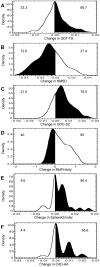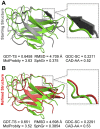i3Drefine software for protein 3D structure refinement and its assessment in CASP10
- PMID: 23894517
- PMCID: PMC3716612
- DOI: 10.1371/journal.pone.0069648
i3Drefine software for protein 3D structure refinement and its assessment in CASP10
Abstract
Protein structure refinement refers to the process of improving the qualities of protein structures during structure modeling processes to bring them closer to their native states. Structure refinement has been drawing increasing attention in the community-wide Critical Assessment of techniques for Protein Structure prediction (CASP) experiments since its addition in 8(th) CASP experiment. During the 9(th) and recently concluded 10(th) CASP experiments, a consistent growth in number of refinement targets and participating groups has been witnessed. Yet, protein structure refinement still remains a largely unsolved problem with majority of participating groups in CASP refinement category failed to consistently improve the quality of structures issued for refinement. In order to alleviate this need, we developed a completely automated and computationally efficient protein 3D structure refinement method, i3Drefine, based on an iterative and highly convergent energy minimization algorithm with a powerful all-atom composite physics and knowledge-based force fields and hydrogen bonding (HB) network optimization technique. In the recent community-wide blind experiment, CASP10, i3Drefine (as 'MULTICOM-CONSTRUCT') was ranked as the best method in the server section as per the official assessment of CASP10 experiment. Here we provide the community with free access to i3Drefine software and systematically analyse the performance of i3Drefine in strict blind mode on the refinement targets issued in CASP10 refinement category and compare with other state-of-the-art refinement methods participating in CASP10. Our analysis demonstrates that i3Drefine is only fully-automated server participating in CASP10 exhibiting consistent improvement over the initial structures in both global and local structural quality metrics. Executable version of i3Drefine is freely available at http://protein.rnet.missouri.edu/i3drefine/.
Conflict of interest statement
Figures








References
-
- Kopp J, Bordoli L, Battey JND, Kiefer F, Schwede T (2007) Assessment of CASP7 predictions for template-based modeling targets. Proteins: Structure, Function, and Bioinformatics 69: 38–56. - PubMed
-
- Mariani V, Kiefer F, Schmidt T, Haas J, Schwede T (2011) Assessment of template based protein structure predictions in CASP9. Proteins: Structure, Function, and Bioinformatics. - PubMed
-
- Jauch R, Yeo HC, Kolatkar PR, Clarke ND (2007) Assessment of CASP7 structure predictions for template free targets. Proteins: Structure, Function, and Bioinformatics 69: 57–67. - PubMed
Publication types
MeSH terms
Substances
Grants and funding
LinkOut - more resources
Full Text Sources
Other Literature Sources
Miscellaneous

